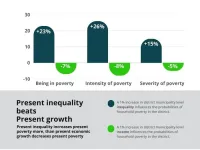(Press-News.org) SAN ANTONIO — March 11, 2025 —Southwest Research Institute (SwRI) has received a three-year, $2,999,998 million grant from NASA to identify and characterize life and its biosignatures in frozen sand dunes in Alaska, under conditions similar to dune fields on early Mars and Saturn’s moon Titan. The Assessing Regional Reflectors of Astrobiology in Kobuk dunes for Interplanetary Science (ARRAKIS) project team, which includes researchers from Brigham Young University and the University of California—Davis, seek insight into how microbial life may thrive in extreme environments on other worlds by understanding the limits on and constraints affecting life in similar planetary analog environments on Earth.
“Basaltic and gypsum sand dunes on Mars and hydrocarbon sand dunes on Titan experience freezing temperatures. Understanding how frozen sands in Earth’s Arctic interact with and support microbial life can help us learn how to search for life in similar frozen conditions elsewhere in the solar system,” said SwRI Staff Scientist Dr. Cynthia Dinwiddie, the principal investigator of the project.
The researchers plan to study the Great Kobuk Sand Dunes in Alaska’s Kobuk Valley National Park to understand the lifeforms living in nutrient-poor sand dunes subject to extreme conditions typical of the Arctic. The 25 square miles of dunes freeze annually at their surface and may include a core of dry permafrost — sand with little or no moisture that remains frozen during the warm season.
“We’ve seen water perched in the near surface of the tallest dunes in Kobuk Valley,” Dinwiddie said. “Perched water occurs when an impermeable layer traps water above it, creating a separate reservoir perched above the regional groundwater aquifer. Water is essential to life on Earth, so SwRI is targeting this perched liquid water for several types of astrobiological analyses.
Water may be perched on an impermeable layer consisting of ice, carbonates or fine-grained material like clay, each of which may accumulate at the base of the actively freezing and thawing layer. Approximately 7% of this dune sand consists of carbonate grains, and exhumed carbonate layers have been observed on the surface of the low-lying areas between dunes.
The researchers will locate these deep, nutrient-poor but wet zones in the frozen sand dunes using near-surface geophysics and biogeophysics methods to pinpoint their depth-dependent search for life. The team will conduct research at the Great Kobuk Sand Dunes twice in 2025, both in the month of March and again in late summer, to observe how the changing seasons affect the activity levels of microbes living deep beneath the surface.
To accomplish this, the researchers will use Raman spectroscopy, which identifies covalently bonded compounds via a laser with a single wavelength of light. The portable instrument Astronaut Raman for In situ resource utilization and Astrobiology (ARIA), developed by SwRI’s Dr. Charity Phillips-Lander, uses Raman spectroscopy to examine the mineralogy of samples and identify organic compounds present. This technique helps determine the composition of samples and the presence of certain materials based on how the light wavelength shifts after interacting with a substance.
SwRI will also use gas chromatography/mass spectrometry (GC/MS) to identify and quantify organic compounds within samples from the dunes, and analytical techniques to measure the concentration of adenosine triphosphate (ATP) and total DNA. Because ATP is present in all living organisms, its measurement can be used to assess cellular activity. Total DNA can be used as a rough proxy for biomass.
Life-detection space science missions will require multiple types of measurements like those the ARRAKIS team are using to provide confidence that a detected signal is related to present or past life. By performing these measurements on samples gathered from analogous environments on Earth, the team will provide critical insight into how to look for life in the subsurface of other planets and moons in our solar system, which will benefit future missions like the potential Mars Life Explorer mission that was prioritized in the most recent Planetary Science and Astrobiology Decadal Survey.
“While we don’t know much about lifeforms thriving deep inside frozen sand dunes, perched liquid water located high in these dunes that does not seasonally freeze provides a potential oasis for life in an arctic desert and could help us make useful inferences elsewhere,” Dinwiddie said. “Life finds a way, even in seemingly inhospitable places.”
For more information, visit https://www.swri.org/markets/earth-space/earth-science.
END
SwRI receives $3 million NASA astrobiology grant to study microbial life in Alaska’s arctic sand dunes
Research aims to better understand how life may thrive in harsh environments on other worlds
2025-03-11
ELSE PRESS RELEASES FROM THIS DATE:
Inequality destroys the benefits of positive economic growth for the poor
2025-03-11
A unique analysis of district-level data reveals why inequality is so destructive to the home consumption welfare of people living below the poverty line, especially during times of significant economic decline, such as the COVID-19 pandemic. During negative economic growth, the welfare of the poor should be the main focus area.
Research from the University of Johannesburg shows how inequality can demolish most of the benefits of positive economic growth and social grants for people living in poverty, especially during economic downturns.
The study by Prof ...
HSS presents innovative research aimed at faster recovery after knee surgery at AAOS Annual Meeting
2025-03-11
At this year’s American Academy of Orthopedic Surgeons (AAOS) annual meeting, investigators at Hospital for Special Surgery (HSS) presented several significant studies, with three focused on new ways to help patients recover faster after total knee arthroplasty (TKA), also known as knee replacement surgery.
What follows are highlights from these studies:
Limiting Use of Tourniquets During Knee Replacement Surgery Improves Patient Outcomes
Tourniquets have traditionally been used during TKA to reduce blood loss and the need for transfusions. However, a new study of almost 18,000 patients from 2019 to 2023 found that prolonged tourniquet use was linked ...
Advancing catalysis: Novel porous thin-film approach developed at TIFR Hyderabad enhances reaction efficiency
2025-03-11
Catalytic function and its efficiency play a significant role in industrial reactions, and consistent reforms are made in the methodology to enhance the large-scale synthesis of drugs, polymers, and other desired products. Available catalysts can be homogeneous, which means that they possess the same phase as the reactants and products, making them difficult to separate from the reaction mixture. On the other hand, heterogeneous catalysts are a preferred choice for such reactions because of their ease of separation and reusability.
The past decade has seen the emergence of porous ...
Small, faint and 'unexpected in a lot of different ways': U-M astronomers make galactic discovery
2025-03-11
A discovery made by a team led by researchers at the University of Michigan tugs at the seams of some key cosmic lessons we thought we had learned from our own galaxy.
This new knowledge comes from the outskirts of Andromeda, the Milky Way's nearest major galactic neighbor, where astronomers have found the system's smallest and dimmest satellite galaxy to date.
This dwarf galaxy, named Andromeda XXXV and located roughly 3 million light-years away, is forcing astronomers to rethink how galaxies evolve in different cosmic environments and survive different epochs of the universe.
Although the discovery bears ...
Study finds that supportive workplace culture advances implementation of lifestyle medicine in health systems
2025-03-11
Workplace culture plays an integral role in the successful adoption of lifestyle medicine programming within health systems, according to a new study published in BMJ Open.
Researchers developed case studies of health systems with lifestyle medicine programming that had a diversity of size, location, payer model and patient population. More than 40 individuals from those health systems, including administrative leaders, physicians and other team members involved in lifestyle medicine programs, participated in the data collection.
The study found ...
USPSTF statement on screening for food insecurity
2025-03-11
Bottom Line: The U.S. Preventive Services Task Force (USPSTF) concludes that the current evidence is insufficient to assess the balance of benefits and harms of screening for food insecurity on health outcomes in the primary care setting. According to survey data, 12.8% of households experienced food insecurity in 2022, with 7.7% of households experiencing low food security and 5.1% experiencing very low food security. Nearly one-third of households with incomes below the federal poverty threshold are food insecure. Food insecurity is one among a multitude of medical, psychological, and social conditions ...
‘Fishial’ recognition: Neural network identifies coral reef sounds
2025-03-11
WASHINGTON, March 11, 2025 – Coral reefs are some of the world’s most diverse ecosystems. Despite making up less than 1% of the world’s oceans, one quarter of all marine species spend some portion of their life on a reef. With so much life in one spot, researchers can struggle to gain a clear understanding of which species are present and in what numbers.
In JASA, published on behalf of the Acoustical Society of America by AIP Publishing, researchers from Woods Hole Oceanographic Institution combined acoustic monitoring with a neural network to identify fish activity on coral reefs ...
Cardiovascular health and biomarkers of neurodegenerative disease in older adults
2025-03-11
About The Study: The findings of this study suggest that promoting cardiovascular health in older adults may help alleviate the burden of neurodegenerative diseases, particularly among Black adults, who are known to experience a higher prevalence of cardiovascular disease.
Corresponding Author: To contact the corresponding author, Anisa Dhana, MD, MSc, email anisa_dhana@rush.edu.
To access the embargoed study: Visit our For The Media website at this link https://media.jamanetwork.com/
(doi:10.1001/jamanetworkopen.2025.0527)
Editor’s Note: Please see the article for additional information, including other authors, author contributions and affiliations, ...
Ethics in patient preferences for AI–drafted responses to electronic messages
2025-03-11
About The Study: In this survey study, participants expressed a mild preference for messages written by artificial intelligence (AI) but had a slightly decreased satisfaction when told AI was involved. Patient experience must be considered along with ethical implementation of AI. Although AI disclosure may slightly reduce satisfaction, disclosure should be maintained to uphold patient autonomy and empowerment.
Corresponding Author: To contact the corresponding author, Anand Chowdhury, MD, MMCi, email anand.chowdhury@duke.edu.
To access the embargoed study: ...
Patients’ affinity for AI messages drops if they know the technology was used
2025-03-11
DURHAM, N.C. – In a Duke Health-led survey, patients who were shown messages written either by artificial intelligence (AI) or human clinicians indicated a preference for responses drafted by AI over a human. That preference was diminished, though not erased, when told AI was involved.
The study, publishing March 11 in JAMA Network Open, showed high overall satisfaction with communications written both by AI and humans, despite their preference for AI. This suggests that letting patients know AI was used does not greatly reduce confidence in the message.
“Every health system is grappling with this issue of whether we disclose the use of AI and how,” ...
LAST 30 PRESS RELEASES:
Numbers in our sights affect how we perceive space
SIMJ announces global collaborative book project in commemoration of its 75th anniversary
Air pollution exposure and birth weight
Obstructive sleep apnea risk and mental health conditions among older adults
How talking slows eye movements behind the wheel
The Ceramic Society of Japan’s Oxoate Ceramics Research Association launches new international book project
Heart-brain connection: international study reveals the role of the vagus nerve in keeping the heart young
Researchers identify Rb1 as a predictive biomarker for a new therapeutic strategy in some breast cancers
Survey reveals ethical gaps slowing AI adoption in pediatric surgery
Stimulant ADHD medications work differently than thought
AI overestimates how smart people are, according to HSE economists
HSE researchers create genome-wide map of quadruplexes
Scientists boost cell "powerhouses" to burn more calories
Automatic label checking: The missing step in making reliable medical AI
Low daily alcohol intake linked to 50% heightened mouth cancer risk in India
American Meteorological Society announces Rick Spinrad as 2026 President-Elect
Biomass-based carbon capture spotlighted in newly released global climate webinar recording
Illuminating invisible nano pollutants: advanced bioimaging tracks the full journey of emerging nanoscale contaminants in living systems
How does age affect recovery from spinal cord injury?
Novel AI tool offers prognosis for patients with head and neck cancer
Fathers’ microplastic exposure tied to their children’s metabolic problems
Research validates laboratory model for studying high-grade serous ovarian cancer
SIR 2026 delivers transformative breakthroughs in minimally invasive medicine to improve patient care
Stem Cell Reports most downloaded papers of 2025 highlight the breadth and impact of stem cell research
Oxford-led study estimates NHS spends around 3% of its primary and secondary care budget on the health impacts of heat and cold in England
A researcher’s long quest leads to a smart composite breakthrough
Urban wild bees act as “microbial sensors” of city health.
New study finds where you live affects recovery after a hip fracture
Forecasting the impact of fully automated vehicle adoption on US road traffic injuries
Alcohol-related hospitalizations from 2016 to 2022
[Press-News.org] SwRI receives $3 million NASA astrobiology grant to study microbial life in Alaska’s arctic sand dunesResearch aims to better understand how life may thrive in harsh environments on other worlds






